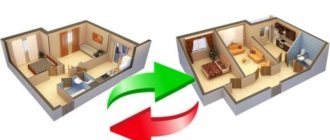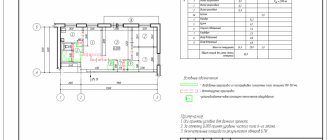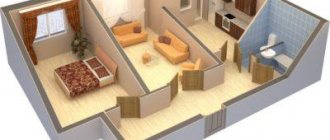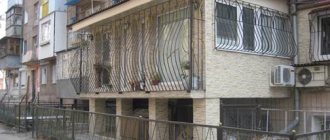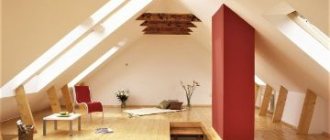Combining a loggia with a room: disadvantages
- The need for additional thermal insulation.
- Complex construction work.
- Material costs.
- A long process of collecting documents and project approvals from supervisory authorities (about 6 months).
There are two options for connecting a loggia to an apartment:
- Partial, includes dismantling the window and balcony door. The wall, window sill and threshold remain in place. This option is the simplest and does not require numerous permits and approvals. If necessary, you can relatively easily return to the original look by simply inserting the window and door into place.
- Complete , all double-glazed windows with frames, walls, window sill and threshold are removed. The owner of the apartment must have permission for redevelopment.
Stages of redevelopment approval
The addition of a loggia increased the area of the hall
In order for the changes to be legalized correctly and without possible prohibitions from the authorities, the following procedure should be followed:
Submit an application to the architecture department of the city in which your apartment is located asking for permission to redevelop it.- Having received permission, order the project from an organization that has a license to conduct development.
- The finished project must be approved by the authorities listed earlier. Each of these organizations must issue its resolution with a permit stamped and signed by the head.
- The package of collected permits and the project are again submitted to the architectural department to obtain a permitting order.
- Now you can begin construction work.
- Upon completion of the work, invite a special commission consisting of utility workers and representatives of the administration. In the presence of engineers from the design organization, the commission must conduct an inspection report and sign a permit to put the facility into operation.
- Submit the package of documents with the object delivery certificate attached to the BTI to issue a new technical passport.
- Issue a new Certificate of Ownership in Rosreestr, providing a new floor plan and technical passport of the apartment.
Do not deviate from a previously drawn up project, even if you think that the changes will be minor. Any violations will prohibit your further actions, and you will have to go through all the stages again.
Is it possible to combine a balcony with a room: legal issues
If you decide to combine a balcony with a room, you must obtain permission to carry out redevelopment work. First of all, you need to call an engineer from the Bureau of Technical Inventory (BTI). He will take measurements and issue a technical passport. To develop a reconstruction project, contact a licensed design bureau or the research institute that designed your house. You also need to get the go-ahead from the Ministry of Emergency Situations, SES, and the Committee for the Protection and Protection of Historical Monuments. You will definitely need a heat calculation and a cadastral extract; this is obtained from Rosriest. Then the collected package of documents is sent to the Housing Inspectorate. And already there a decision is made to allow the connection in accordance with Articles 25 and 26 of the Housing Code of the Russian Federation. After construction work is completed, it is necessary to call an employee of the Housing Inspectorate and draw up a report. After this, the BTI issues a technical passport taking into account the redevelopment of the housing facility.
Remember that illegal alterations may result in litigation, fines, and a court decision to return the apartment to its original appearance. In addition, without a new technical passport, you cannot perform legal actions with the apartment (exchange, sell, mortgage, etc.).
What does the law say?
There is currently no clear legal permission or prohibition to attach a balcony space to a kitchen or room.
Any redevelopment is regulated by Article 25 of the Housing Code of the Russian Federation.
Due to the fact that housing reconstruction may affect the interests of neighbors and disrupt the safety of housing, it is required to carry it out in accordance with GOST, SNiP, and SanPiN. In addition, each region has adopted its own by-laws that supplement federal documents.
The Housing Code of the Russian Federation contains conditions for levying a fine for illegal changes in layout. In addition to a fine, the owner will be required to restore the original appearance. If, in connection with the reconstruction, an emergency situation involving damage occurs, then compensation for losses to the victims will also fall on the shoulders of the offender.
Redevelopment that is not formalized by law can serve as an obstacle to the sale of housing. The changed floor plan makes the previous documents invalid and must be re-issued.
It is possible to coordinate this issue with the new owners, who will agree to arrange everything themselves after the purchase. Only the value of real estate in this case will decrease significantly.
The fine for illegally changing the layout in accordance with the Code of Administrative Offenses (Article 7) is 2-2.5 thousand rubles. If the apartment is not restored to its original appearance, a fine may be re-imposed.
You can learn how to coordinate the redevelopment of a loggia from our article. We also have a sample application for redevelopment.
Balcony redevelopment: main stages of reconstruction
How to insulate a loggia when combined with a room
The air temperature on the balcony in the cold season is much lower than in a living room. Therefore, it is necessary to make thermal insulation and interior finishing of the attached extension. The difficulty is that it is impossible to install central heating radiators here. If you are still living in an apartment at the time of work, it is better to start the renovation by insulating the loggia and installing plastic windows on the balcony.
First, pay attention to the parapet sheathing. If it is very old, completely dismantle it down to the concrete surface. Then make a new cladding with a secure frame.
There are two methods of insulation:
- External or external. This is rarely done because additional permits are required from organizations monitoring the facades of buildings. In addition, when insulating a balcony from the outside, it is necessary to install a thermal fur coat made of mineral wool or polystyrene foam on the walls of the house. To do this, residents of multi-storey buildings must call special equipment for installation work.
- Interior. The most convenient option. Does not require additional approvals. You can do everything yourself (read more in the article “Insulating a balcony with your own hands”).
Before you begin insulation work, remove all furniture and belongings from the room. Carefully examine the cladding and cement or cover any cracks found with foam. Pay special attention to the joint with the parapet. Level the surfaces. After this, waterproof the balcony. Usually a special primer is used, but if the insulation is mineral wool, then a waterproofing film is used.
Materials:
- Styrofoam. The most economical option. Sheets of foam plastic are fixed to the wall frame, the cracks between them are covered with polyurethane foam. Read more in the article “Insulating a balcony with polystyrene foam.”
- Expanded polystyrene or penoplex with a layer of foil. It has excellent strength, is completely fireproof, resistant to dampness and chemical influences. Unfortunately, it is quite expensive. Read more in the article “Insulating a balcony with penoplex”
- Mineral wool is made from fiberglass. It can be driven into almost any crevice. A frame is required for installation.
- Penofol. Supplied in rolls, glued with aluminum tape. This is a very thin material. It allows you to save the area of the insulated object.
- Polyurethane foam. Liquid insulation, it is sprayed onto the surface of concrete structures. When working with it, you can adjust the thickness of the insulating layer.
- Expanded clay. For use on floors only.
Soft insulation requires a balcony frame. There are two types: metal or wood. Mostly they use metal ones, as they are stronger and more durable. The top of the structure is covered with plasterboard sheets, the joints are sealed and then puttied.
To improve thermal insulation when glazing an attached loggia, two- or three-chamber plastic double-glazed windows are used. They also have good sound insulation. To increase resistance to wind gusts, it is recommended to install only one opening frame.
To heat the new room, a convector is installed and oil radiators are installed (read more in the article “Moving the battery to the loggia”). The most convenient solution to this problem is a warm floor on the balcony. Pay attention to the infrared heating system. It is easy to install yourself. If malfunctions occur, damaged elements can be replaced. There is no need to completely open and repair the thermal floor. The possibility of separately switching on individual sections will allow you to heat only the part of the floor that you choose. This reduces heat loss and saves energy.
Attaching a loggia to a room by removing the window opening
If you have not received permission to completely connect the balcony, you need to limit yourself to removing the window and balcony door. In this case, the former window sill becomes an element of the interior. It can be converted into a table, a bar counter (read more in the article “bar counter on the balcony”) or a shelving unit. The doorway can be closed with sliding doors and decorated with curtains.
If your project of combining a room with a balcony has been approved by all authorities, you can completely dismantle the partition with double-glazed windows.
But in many cases you will not be able to achieve complete unification of space. The problem lies in the different floor levels of the connected room and room. In some series of panel houses (for example, p44t loggias), it is impossible to remove the threshold to the balcony, because it holds the balcony slab. The result of such dismantling will be the collapse of the balcony and damage to the neighboring ones. It should also be taken into account that the recess above the opening is part of the supporting structure and cannot be dismantled.
And what if you don’t have a loggia, but a balcony?
Check: you have a loggia or balcony
If it’s a balcony, you can glaze it at most, and not every one. It is impossible to attach the balcony to the room (it will collapse).
The difference here is this. In accordance with SP 54.13330.2011 “SNiP 31-01-2003. Residential multi-apartment buildings, a loggia is a room
"(clause 3.10).
area
protruding from the plane of the facade wall ” (clause 3.8). It is theoretically possible to attach a room (loggia), but a fenced area cannot be attached to a room.
Related article: Is it possible to move the battery to the loggia
The loggia has a ceiling and walls on three sides. This photo shows an example of a loggia.
Fact:
In one house, even in one apartment, there can be both a loggia and a balcony.
Why know the difference between a balcony and a loggia
If you want to approve warm glazing for a balcony in an old building, you will most likely receive a negative conclusion.
Our advice to you: install a trellis for planting plants in the spring, renew the floor with a terrace board and use the balcony for its intended purpose - for relaxation.
The maximum you can count on if you have a balcony is single glazing
I'll glaze! What problems
If we are talking about a loggia, its ceiling is supported on three sides. The loggia can withstand significant loads.
At the same time, the limit for a balcony is 200 – 250 kg/sq.m, and this includes everything: the fence, all the stored utensils, and a company of three or four people who came out to breathe.
But that's not all. The above load value is for new houses. Every year it decreases in accordance with the degree of wear and tear of the building (in standard BTI practice - by 1% per year). Thus, for a “socket” that has lasted half a century, the value of the maximum permissible load on a balcony of 3 sq.m is no longer 600, but 300 kg.
For reference:
10 sq.m of a standard single-glazed window with 4 mm glass is already 200 kg.
“Overloading” a wall panel with an insulated balcony can cause it to “go for a walk,” and cracks will constantly open in the corners. But this is not the biggest problem. “The most” is when the balcony falls.
By the way:
It is unlikely that anyone will fine you. Officials are even comfortable with inconsistent glazing, just like you. After all, if an overloaded old balcony falls, the responsibility will fall on the owner, and not on the municipality and utility services.
Conclusion:
In most cases, it is safer for balcony owners to abandon the idea of glazing.
Permission for redevelopment may not be given
Is it possible to combine a kitchen with a loggia? It is possible, but not always. It is possible to legally connect a loggia with a kitchen or another room if the following conditions are met:
- You have a loggia, not a balcony.
- You have a relatively new monolithic house, and you have the opportunity to get a technical opinion first-hand (from the authors of the project).
- You have joined forces with your HOA neighbors (cheaper in bulk) and brought in energetic professionals who specialize in approvals.
Important:
If the redevelopment affects load-bearing structures (for example, when expanding openings), an expert opinion should be given by the author of the building design. That is, if the house is new, there will most likely not be any problems with combining the loggia with the kitchen (and its coordination).
With the old foundation and Soviet buildings, everything is more complicated. Here, the “authors” are usually the successors of Soviet design institutes, and sometimes it’s not easy to find the answers.
Panoramic door - a new “Moscow” formality
Legalizing the complete connection of a loggia to a kitchen or room becomes more and more difficult over the years. There is no direct prohibition in Russian legislation, but each region has its own specifics.
In Moscow, Resolution No. 508-PP of October 25, 2011 prohibits:
- “combination of loggias, balconies, terraces, verandas with interior spaces” (clause 10.19);
- “transfer of heating radiators connected to the general house hot water supply and (or) central heating system to loggias, balconies, verandas and terraces” (clause 10.7).
In practice, this means that redevelopment is possible only if the functional purpose of the premises is preserved. That is, the room (kitchen) should remain a room (kitchen), the loggia should remain a loggia, and between them there should be a double-glazed window.
The “passable” (in terms of approvals) option is to install a hermetically sealed panoramic accordion door with double glazing instead of a standard window. But central heating radiators in Moscow loggias are illegal. If you want a winter garden, install electric convectors, make sure that the temperature does not drop below zero. And deal with rising energy bills.
Regions: what is not prohibited is permitted
Residents of regions where the ban on combining loggias with kitchens and rooms has not yet reached them has wider opportunities. They can do without the “formalities” in the form of panoramic doors. But, unfortunately, they are in no hurry to approve “balcony” redevelopments - it is long, expensive and “the neighbor did it, and nothing.”
Related article: Technology of insulating a loggia with penoplex
For your own safety, don't do anything stupid. Experts are extremely reluctant to approve projects for connecting a room/kitchen with a loggia, which involves dismantling window sill blocks and widening the openings in the panels. Probably not in vain, right?
Combining a loggia with a room according to the law
If the apartment has a loggia, then in order to increase the living space, many residents of multi-storey buildings combine the loggia with a room.
Is combining a loggia and a room considered redevelopment?
The concept of redevelopment includes any dismantling and installation work that leads to a change in the current floor plan.
To combine a loggia with a room, you will need to change the window and door opening, which is a redevelopment. Therefore, the answer to the question posed is clear - if you combine a room and a loggia, then you are doing a real redevelopment.
At the same time, as with any other type of redevelopment, you must first obtain permission to combine a loggia with a room.
Is it legal to combine a loggia with a room?
Another frequently asked question, the answer to which requires a little explanation. Combining a room with a loggia is legal, but such redevelopment must be carried out correctly.
Unfortunately, such work is often not pre-coordinated by the owners of the premises with local authorities and, as a result, is carried out with serious violations of building codes and regulations.
Let's see what the legislation says about combining a loggia with a room. Let us turn to two fundamental documents covering this issue:
- Resolution of the State Committee of the Russian Federation for Construction and Housing and Communal Sector dated September 27, 2003 No. 170 “On approval of the Rules and Standards for the Technical Operation of the Housing Stock.”
- Decree of the Moscow Government of October 25, 2011 No. 508-PP “On the organization of reconstruction and (or) redevelopment of residential and non-residential premises in apartment buildings and residential buildings.”
Clause 4.2.4.9 of the first resolution states that the use of loggias for purposes other than their intended purpose is not permitted . In addition, bulky and heavy items should not be placed on them.
And in paragraph 10.19 of the second resolution it is directly stated that during redevelopment it is prohibited to combine the loggia with the interior spaces of the apartment - kitchens, corridors and rooms.
This means that the housing inspectorate, which issues permits for redevelopment to owners of apartments in the capital, will refuse to approve renovations in which the loggia will become part of the living room.
Project for redevelopment of an apartment with a combination of a loggia and a room in a panel house of the P3 series:
You will immediately have a question, how can this be, because only on Internet portals dedicated to interior design can you easily find hundreds of photographs of residential premises, in which loggias attached to the rooms are clearly visible?
Moreover, the options for combining a loggia with a room are depicted in a variety of ways: in some apartments the window and door to the loggia are removed, and the window sill block is adapted for a computer desk, decorative shelf, etc., in others there is no partition at all between the rooms, that is, a window -the door frame and window sill part of the wall were completely dismantled.
What can you answer here? Every year, Muscovites carry out thousands of illegal redevelopments in their apartments, and then try to legalize them through the Moscow Housing Inspectorate. In the photographs with a full-fledged combination of a loggia and a room, you can see examples of such unauthorized redevelopment, for which administrative responsibility is provided.
By the way, not all such redevelopments are illegal. Many could have been made several years ago, when combining a loggia with a room in its “pure form” was still allowed. But now such redevelopment is prohibited.
How to legalize the combination of a loggia with a room?
It is impossible to make a loggia with a room into a single space. The law clearly states that premises must be separated. But you can differentiate between a loggia and a room, for example, with a translucent partition in the form of floor-to-ceiling French doors.
These doors are very practical and have an unusual appearance. They visually enlarge the living space, transform the design of the premises and ensure the penetration of street light.
But most importantly, if you have the idea of combining a loggia with a room, then you can coordinate such a redevelopment only by replacing the window, door and standard window sill with glass doors. There is no other legal way to “combine” cold and heated rooms today.
Is it possible or not?
There are a number of restrictions depending on the condition of the building and its load-bearing elements. To understand whether it allows for reconstruction, you should contact an engineering company. The list of prohibited reconstruction measures is contained in the current codes, regulations and technical standards.
Related article: Which lining is best for a loggia
Rules and regulations
The legislation does not provide a clear answer that satisfies all conditions. The Housing Code of the Russian Federation states that redevelopment is considered to be any change in load-bearing structures that requires display in the BTI plan. Such changes include the demolition of the balcony block and the expansion of the opening. Such events should be carried out only after approval from government authorities. To do this, a project is drawn up based on a survey of the building using special engineering equipment and calculations performed by specialists from design organizations. By law, only companies with the appropriate license can engage in projects.
Housing must meet certain sanitary and technical requirements given in GOSTs and SNiPs. If they are violated, the design documentation cannot be agreed upon. It will not be possible to legitimize it retroactively after repair work has been carried out - the commission will oblige the apartment owner to return the property to its previous appearance. If this is impossible, the damaged structures will have to be strengthened - otherwise they will pose a threat to the life and health of residents, as well as bystanders. Needless to say, how dangerous a poorly secured horizontal slab is.
Reinforcement, as a rule, looks very bulky and consists of wide metal beams that take up more than 20 cm of the height of the room. It is unlikely that such a solution will suit the owners of an apartment in a panel house if they know in advance that a huge threshold that is difficult to overcome will appear in their compact kitchen.
In addition to the Housing Code of the Russian Federation and sanitary and technical norms and rules, local legislation applies. Moscow Government Decree No. 508-PP states that connecting a balcony to an interior space is a prohibited event. This means complete dismantling of the wall. The decree introduces a ban on moving a radiator connected to the hot water supply system or central heating pipes outside the room or kitchen. No design organization will undertake to coordinate such a decision.
According to the law, it is prohibited to carry out repair work in which the strength of load-bearing structures is lost. To understand whether reconstruction is possible, you will need to conduct a technical examination. To do this, you need to contact an engineering company that has the appropriate license.
List of restrictions
If you put together all the factors that influence obtaining a permit, you can come up with a list of restrictions that apply under any circumstances. The following is not allowed in an apartment in a residential building:
- moving the radiator outside the kitchen and room;
- complete dismantling of the external wall - if it is removed, the balcony slab will have nothing to rest on;
- eliminating the reinforced concrete lintel above the opening - without it, the wall panel will lose strength;
- elimination of the threshold - a cantilever structure is attached to it;
- cutting down the side walls of the loggia, as well as increasing its size, which is reflected in the appearance of the building;
- glazing - if the house is an architectural monument and its appearance must remain unchanged.
How to legalize the addition of a balcony or loggia to a room
The housing problem has plagued people since time immemorial.
We are constantly trying to expand our living space. One of the fairly common ways to increase the area of a living space is to add a balcony or loggia to the room. Please note that such alterations require approval from local governments and technical supervision services. Of course, many try to ignore this rule, and installers (if they are involved) do not insist on agreeing on the rework. And if your balcony or loggia was glazed before the redevelopment, it is generally very difficult to see signs of repair from the street. After all, inspection bodies won’t be going door to door. However, when selling, exchanging, donating or inheriting real estate, you will still have to document the alteration, so wouldn’t it be better to legalize everything in advance?
Well, don’t forget about the vigilant neighbors who are always ready to report “where it should be” when they discover the slightest violations, which, by the way, lead to the payment of rather large fines, the mandatory approval of the merger of sites, or even the complete restoration of the wall. In addition, any amateur construction activity can spoil the appearance of the building or even cause its destruction. And this, as you understand, is causing harm to someone else’s property, and in extreme cases, to human health.
Let's make a reservation right away: the norms of the Housing Code of the Russian Federation regarding the approval of redevelopments apply only to new actions, that is, to those that were carried out after December 2004 (after changes to the code came into force).
If the redevelopment was carried out before the adoption of the RF Housing Code, you can also begin the process of legalizing it. There is no need to prove that you made repairs before the introduction of mandatory approval requirements. True, the procedure will take more time - after all, you will have to convince the housing inspector that the alterations already made are safe. Of course, you can leave everything as it is, because in fact you are not breaking the law.
But, as mentioned earlier, problems may arise during sale, exchange, etc. apartments - in this case, approval will have to be carried out without fail, but in less comfortable conditions and with a lack of time. In addition, experience shows that over time, some types of redevelopment may become illegal, so it is better to legalize changes already undertaken now. Finally, even if you were denied legalization of your attached balcony in the usual manner, this can be done through the court - after conducting additional examinations on hidden work. However, the probability of such a decision is 50/50.
So, if you still decide to act according to the law and are going to agree on the combination of an apartment (room) and a balcony (or loggia), then the following text is intended just for you. When registering a redevelopment, you will have to go through several stages. The first is preparatory, during which we recommend collecting the most complete information about such construction work. Read magazines, surf the Internet - see what has already been done before you, which projects were successful and which were not. It is also worth getting an idea of the cost of such transformations - at least roughly estimate the upcoming costs, study the prices of building materials, and choose a suitable contractor. The next stage is drawing up and agreeing on a redevelopment project, plus obtaining permission from the housing inspectorate for redevelopment. To avoid mistakes, contact the design office. Remember that such organizations must have the appropriate license, otherwise it will not be possible to approve the project. By the way, it is more economically profitable to choose a company that not only develops the necessary documentation, but also carries out construction work.
Alignment process
Typical apartments do not have a large area, and kitchens can only accommodate the necessary equipment and furniture.
Remodeling a kitchen with a balcony, the photo below shows it, can change the interior both visually and functionally. The balcony as an extension of the kitchen is the result of a successful combination
To connect the balcony to the kitchen, it is enough to confine yourself to dismantling the window unit. The remaining combined section of the wall can be used as:
- Stolika
- Bar counter
- Cabinets
- Countertops for hobs, etc.
Combining a kitchen with a balcony, the photo below shows this, will help you make rational use of the new space.
Combining the work area and window sill
The attached space of the former loggia can be turned into a dining room or pantry, and if the area allows, then the work area can be moved to the balcony
- The balcony is a suspended structure and cannot be overloaded, so before removing heavy furniture and appliances, it is worth calculating the loads on the attached space.
- Autonomous wiring and the presence of sockets on the balcony are not allowed; electrical appliances are connected to a network located in the kitchen itself. This can be done using an extension cord, hiding the wires in a special box or pipe.
In practice, a combined loggia must be as insulated as possible, otherwise there is no point in thinking about construction work. Therefore, before making a room out of a loggia, it is recommended to start with its insulation and “re-glazing”. The old window profile is removed, since its design often does not meet the requirements for thermal protection of the room. Then the door that previously separated the loggia and the room is dismantled.
Is it possible to combine a balcony with a room? Yes, and it will be cool!
Not all balconies are so spacious that after glazing they can be used as desired. If the adjacent room is also small in area, a tempting idea often comes to mind to combine these two rooms.
Any “alteration” affecting the configuration of the apartment must be carried out with the permission of the supervisory authorities. The sequence of actions is clearly indicated - first permission, then work. Otherwise, it is far from certain that the changes will be legalized, even if they did not lead to negative consequences.
Considering that the facade wall is a load-bearing structure, any actions with it must be coordinated with local authorities, not to mention the complete demolition of the panel. Therefore, let’s consider whether it is possible to combine a balcony with a room, whether there are safe ways, and how to do this without breaking the law.
Approvals for the redevelopment project
To demolish the window sill and part of the outer wall, you must obtain permission . In clause 3.1 of Appendix 1 to the Post. Right Moscow No. 508 indicates that such actions constitute a change in design.
A redevelopment project is required, which is directly indicated in clause 4.7 of Appendix 3. Formulas with completed thermal engineering calculations must be attached to the redevelopment project.
Batteries (heating radiators) on the balcony
The general rule is this: radiators are prohibited from being placed on a balcony or loggia. The requirement is prescribed at the level of clause 10.7 of the Appendix. 1 k Post. Moscow Government No. 508, as well as other documents.
Legislation prohibits placing on balconies and loggias:
- water radiators;
- water heating systems;
- any other utilities that come from the risers of the heating system (for example, it will not be possible to make a sauna or swimming pool).
As for electric heating and heating systems, they are allowed . There are no prohibitive rules. But be prepared for the fact that if something happens, you will have to obtain a court decision to preserve the redevelopment.
Attaching a conservatory or veranda to a room
If such objects exist in reality, then they are indicated “on paper” (i.e. in the design documentation). Next we study the nuances of the BTI explication.
There are 2 options for the development of the situation:
There is one more point. In the inventory documents for the apartment (i.e., in the plans and in the BTI explications), the actual area of the balcony is multiplied by a reduction factor of 0.3. Those. the information provided in the technical documentation does not correspond to reality. So you’ll have to go around with a tape measure and measure everything again.
We hope that there will be no problems with the redevelopment. Choose your option for combining space and enjoy new areas!
Video: How to attach a balcony to a room?
Combining a balcony with a kitchen or room is a common issue when renovating an apartment. With a few extra square meters, the kitchen can be turned into a dining room, and the room can have a small office.
However, in 2020 this redevelopment was prohibited. Such measures were taken due to the fact that inconsistent layouts harm the entire building.
For example, in 2011 in Yaroslavl, a resourceful entrepreneur demolished a load-bearing wall in an apartment on the 1st floor to make renovations for a store. The investigation - the entrance collapsed, 18 apartments were destroyed, 67 people were left without housing, 1 was killed.
In 2020, a three-story building collapsed in Kazan due to redevelopment. 4 people were injured, 60 were left without apartments.
What is forbidden to do when remodeling a balcony:
- remove batteries into this room
- remove the lintels above the opening
- dismantle the threshold when removing the window sill block
- completely combine the balcony with the kitchen
- trim the side walls of the balcony
- create additional loggias
- extend the balcony beyond the level of the facade wall.
How to do everything right?
Merge partially
The room with the balcony had to be divided. Sliding doors will come to the rescue. A prerequisite is double glazing and guides at the top and bottom. This is only permissible in monolithic houses where the facade is not a load-bearing wall. In panel, block and brick houses, demolishing a window sill, top lintel or threshold is dangerous.
Legal side of the issue
Adding a loggia or balcony to an apartment is a very popular redevelopment, but this is not always possible. Errors made - technical and organizational - are fraught with problems with government agencies and the management company. As a result of such redevelopment, the loggia is spatially combined with the apartment by dismantling the window and door blocks, often with complete or partial dismantling of the wall, and this operation must be approved according to the standard procedure prescribed in the Housing Code of the Russian Federation.
The legal status of the loggia is an unheated room that is part of the apartment. The area of the loggia is not counted towards the total area of the apartment, but is included within its boundaries and is recorded in the title documents for housing. In other words, the loggia, as well as the right to dispose of it, belongs to the owner of the apartment.
Consequences of redevelopment without approval
If unauthorized redevelopment is discovered, according to Article 9.12 of the Code of Administrative Offenses, the resident is fined up to 2,500 rubles. In addition to the fine, the apartment owner must return the residential premises to their previous condition, maintaining the area of the balcony and rooms in the dimensions established by the developer. If you refuse to comply with the legal requirement of the housing inspection, the apartment is confiscated from the owner through the court and sold through auction. The proceeds from the sale of real estate are returned to the former owner, except for the amount that was spent on eliminating violations.
If you manage to combine a living space with a loggia without approval, without getting caught in illegal actions, this will still lead to unpleasant consequences in the future when selling the apartment. In case of legal design changes, all new dimensions are entered into the technical passport of the housing. The owner will need this documentation in the event of an unscheduled inspection by the housing inspection, as well as when selling the property. In its absence, it will be difficult to agree on a deal with buyers, since not everyone will agree to take responsibility for illegal redevelopment.
Is it always possible to attach a loggia to an apartment?
The possibility of combining a loggia with an apartment depends on the availability of technical conditions for changing the warm contour of the apartment. Therefore, the technical feasibility is assessed in each individual case by the design organization and, if it exists, the same institution develops a redevelopment project that meets all the requirements.
No less important is another technical question - is it permissible to change the load on existing utility networks. When developing a redevelopment project, the design organization evaluates existing technical capabilities and offers a technical solution that can be implemented in a specific apartment in a specific building.
Basic criteria for the possibility of legally connecting a loggia to an apartment
So that the hassle of coordinating the redevelopment does not turn out to be useless, you can independently evaluate the possibility of attaching a loggia to the room in a legal way. To do this, you need to pay attention to 3 main points:
- External glazing.
- The wall between the loggia and the apartment.
- Possibility of changing the warm circuit.
External glazing The attached loggia must be glazed in one of two ways:
- glazing from the developer;
- independently - in strict accordance with the approved concept of glazing the entire façade of the building.
If there is no glazing from the developer, and there is no approved concept, it will not be possible to coordinate the connection of the loggia to the apartment. It will not be possible to legitimize such redevelopment if it is carried out without permission.
Wall between the loggia and the apartment If the wall is load-bearing, then its dismantling is prohibited. If the wall is not load-bearing, complete dismantling of this structure is possible, but with reservations.
When the apartment is located above 15 m from the ground level, fire safety rules come into play - complete dismantling of the wall is possible only if there is a second loggia on which you can hide from fire. If there is no second loggia, complete dismantling of the wall is impossible - it is necessary to leave a fire-proof blind partition at least 1.2 m wide.
Possibility of changing the warm circuit. This refers to the possibility of ensuring the standard temperature in the attached loggia. If this is not possible, they will not be allowed to attach a loggia to the apartment, but in real life such a situation is unlikely. The fact is that it is prohibited to move a heating radiator to the loggia unless it is connected to the apartment. After joining, the loggia becomes part of the heated room, and it is possible to place a heating radiator in it, for example, on a parapet. If the enclosing structures are insulated, the standard temperature in the room will be ensured.
It is only possible not to approve the connection of a loggia to a room in one case - if it is already glazed legally, and the unification of the premises consists only of dismantling the window and door units.
Finishing the window sill block of the wall under a table, bar counter or flower cabinet allows you to smooth out some of the inappropriateness of its location.
In what cases the project may not be approved
At the second stage, you may be refused to draw up a project for the following reasons:
- The restructuring is contrary to emergency and fire safety standards.
- If the apartment building already has several converted apartments. In such cases, the reason for refusal is the probable violation of the supporting structures.
- If the reconstruction threatens changes in load-bearing structures.
- If the loggia is different in appearance and extends beyond the other balconies in the house.
As you can see, to reconstruct the loggia you will have to run around a lot, collecting all the necessary papers. However, you will end up with additional living space.
Dear readers! If you have any questions on the topic “How to legalize the addition of a loggia to a room” or have any other questions, ask them right now - use the online consultant form or call us at 8(800)-350-30-02 (call and consultation free for all regions of Russia)!
Was the Recording helpful? No 3 out of 3 readers found this post helpful.
The nuances of connecting a loggia to an apartment
When a loggia is attached to an apartment, the warm contour of the apartment changes - its elements become the window frame and all enclosing structures in contact with the outside environment or neighboring cold rooms. Therefore, the floor, ceiling, parapet and side walls are insulated, and if these measures are insufficient, the loggia is equipped with additional heating. If the existing heating system in the house allows you to increase the heating load of a separate apartment, then additional radiators are installed on the loggia. This makes it possible to do without electric heating devices, but the possibility of such a solution is assessed only by the design organization.
In the absence of such a possibility, “warm” floors or infrared panels are most often used as additional heating systems. The necessary technical characteristics of these devices are calculated by the design organization and recorded in the redevelopment project.
When weighing the pros and cons of such a redevelopment, you should also know the following:
- Legally, the possibility of connecting a loggia does not depend on its area, but may depend on technical conditions;
- The total area of the apartment after the addition of the loggia changes not only in fact, but also in documents - the square footage of the attached premises is added to it, which was not previously taken into account;
- The cost of utilities after connecting the loggia will increase, since the amount is calculated taking into account the total area of the apartment, and it has increased;
- Attaching a loggia to an apartment along its entire length is legally possible, but the technical feasibility is determined in each individual case by the design organization;
- There is no need to coordinate the redevelopment with the management company - these organizations do not have the authority to approve and therefore cannot interfere with the work if the owner of the property has a project for connecting the loggia to the apartment, agreed with the local authorities.
How to apply for a permit?
Coordination of combining a balcony with a room is required only if you choose the second or third reconstruction options. When the door and windows are removed, but the loggia is well insulated, this is not considered a redevelopment. The only problem you may encounter is if, when selling the apartment, the new owner demands that the door and window be returned to their place. However, such issues can be easily resolved privately.
Permission can be denied for only a few reasons:
- dismantling the exit to the balcony can lead to the destruction of the house;
- the house is a city architectural monument;
- an increase in living space in an apartment requires additional heating, but thermal communications in the house do not allow this;
- a balcony/loggia is a place for evacuation in case of fire, and turning it into a living room will reduce the chances of a quick evacuation.
For redevelopment it is necessary to issue a re-registration
But if the first 2 points are missing in your case, there will probably not be any serious obstacles when agreeing to combine the balcony with the room. So, the main stages of obtaining permission for redevelopment:
- We contact the local BTI to issue a registration certificate for housing.
- We draw up a redevelopment project taking into account the unification and coordinate it with the author of the house project.
You can contact a licensed construction and design company or directly to the design institute that developed the design of your house (get both the design and approval in one place). If the institute no longer exists, the document can be approved by a local expert organization.
- In some cases, it is necessary to obtain permission for a ready-made project from a number of other departments: the Ministry of Emergency Situations, Sanitary and Epidemiological Supervision, the management company, resource organizations, etc.
- We submit all documents to the housing inspectorate for permission.
- After the dismantling and construction work, we call the housing inspection staff (sometimes the BTI) to draw up a report, then we go to the BTI to draw up new documents for the apartment.
Today there are special licensed organizations that are ready to take on not only the preparation of the project, but also the execution of all the paperwork for redevelopment. In this case, combining the loggia with the residential part of the apartment will cost more, but you will get rid of a lot of hassle and save time.
